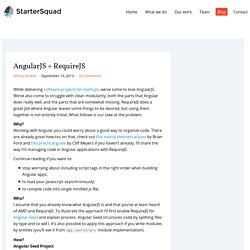

AngularJS + RequireJS. While delivering software projects for startups, we’ve come to love AngularJS.

We’ve also come to struggle with clean modularity, both the parts that Angular does really well, and the parts that are somewhat missing. RequireJS does a great job where Angular leaves some things to be desired, but using them together is not entirely trivial. What follows is our take at the problem. Why? Working with Angular you could worry about a good way to organize code. Continue reading if you want to: stop worrying about including script tags in the right order when building Angular apps;to load your javascript asynchronously;to compile code into single minified js file; Who? I assume that you already know what AngularJS is and that you’ve at least heard of AMD and RequireJS. How? Angular Seed Project Let’s check how Angular Seed structures code.
Let’s start the party. Add RequireJS Checkout the example in your browser or on github. Installing dependencies I used bower to do this for me. Index.html <! Main.js. Why will Angular 2 rock? This article has been update in October 14th.

Now it is using TypeScript and angular 2.0.0-alpha.42 Note: If the “foo” alerts from the plunkers starts popping out without reason, please leave a comment and I will look for a different solution. DISCLAIMER: Angular 2 is still in Alpha stage so the syntax I present in here is subject to be changed and|or simplified. I am using Angular 2.0.0-alpha.42.
Also, what I write in here is just my opinion and I could be wrong. Is there any estimate for Angular JS 2.0 release date? Angular is a development platform for building mobile and desktop applications - Angular. AngularUI for AngularJS. A Practical Guide to AngularJS Directives. Tutorial: 4 - Two-way Data Binding. Loading...

In this step, we will not be adding any new functionality to our application. Instead, we are going to take a step back, refactor our codebase and move files and code around, in order to make our application more easily expandable and maintainable. In the previous step, we saw how to architect our application to be modular and testable. What's equally important though, is organizing our codebase in a way that makes it easy (both for us and other developers on our team) to navigate through the code and quickly locate the pieces that are relevant to a specific feature or section of the application.
To that end, we will explain why and how we: Put each entity in its own file.Organize our code by feature area, instead of by function.Split our code into modules that other modules can depend on. We will keep it short, not going into great detail on every good practice and convention. Reset the workspace to step 4. git checkout -f step-4 The most important changes are listed below. Angularjs.